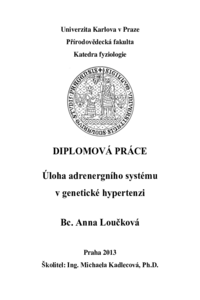Úloha adrenergního systému v genetické hypertenzi
The role of adrenergic system in genetic hypertension
diplomová práce (OBHÁJENO)

Zobrazit/
Trvalý odkaz
http://hdl.handle.net/20.500.11956/53442Identifikátory
SIS: 116797
Kolekce
- Kvalifikační práce [19614]
Autor
Vedoucí práce
Konzultant práce
Pácha, Jiří
Oponent práce
Husková, Zuzana
Fakulta / součást
Přírodovědecká fakulta
Obor
Fyziologie živočichů
Katedra / ústav / klinika
Katedra fyziologie
Datum obhajoby
29. 5. 2013
Nakladatel
Univerzita Karlova, Přírodovědecká fakultaJazyk
Čeština
Známka
Výborně
Klíčová slova (česky)
genetická hypertenze, krevní tlak, adrenergní systém, spontánně hypertenzní potkan, tyrosinhydroxylasa, DOPA-dekarboxylasa, dopamin-β-hydroxylasa, fenyletanolamin-N-metyltransferasa, adrenergní receptoryKlíčová slova (anglicky)
genetic hypertension, blood pressure, adrenergic system, spontaneously hypertensive rat, tyrosine hydroxylase, DOPA decarboxylase, dopamine β-hydroxylase, phenylethanolamine-N-methyltransferase, adrenergic receptorsAdrenergní systém hraje významnou roli v regulaci krevního tlaku. U spontánně hypertenzního potkana, nejvíce studovaného modelu esenciální hypertenze, je mnoho součástí adrenergního systému změněno. Změny v úrovni exprese některého z enzymů biosyntetické dráhy katecholaminů nebo některého podtypu adrenergních receptorů by mohly být jednou z příčin vzniku hypertenze. V této práci byla měřena exprese genů adrenergního systému v nadledvině, kůře ledvin a dřeni ledvin u třináctitýdenních spontánně hypertenzních (SHR), Wistar-Kyoto a Brown Norway potkanů. V nadledvině SHR byla snížená exprese všech enzymů biosyntetické dráhy katecholaminů (tyrosinhydroxylasy, DOPA-dekarboxylasy, dopamin-β-hydroxylasy a fenyletanolamin-N-metyltransferasy) a téměř všech podtypů adrenergních receptorů (kromě Adra1a a Adra1d). Toto celkové snížení exprese v nadledvině SHR naznačuje, že alespoň část regulace exprese genů adrenergního systému je společná. Mechanismem útlumu exprese u SHR může být zpětná vazba přes adrenergní receptory stimulované vysokou plasmatickou koncentrací noradrenalinu. V ledvině SHR nebyl zjištěn rozdíl v expresi většiny podtypů adrenergních receptorů s výjimkou Adrb1 a Adra2c, jejichž exprese byla zvýšená. Tento rozdíl v expresi je spíše důsledkem nebo průvodním jevem než příčinou vzniku hypertenze.
The adrenergic system plays an important role in the regulation of blood pressure. In the spontaneously hypertensive rat, the most studied model of essential hypertension, many components of the adrenergic system are altered. Changes in expression level of any catecholamine biosynthetic enzymes or any adrenergic receptor subtypes could be one of the causes of hypertension development. In this work, the expression of adrenergic system genes was measured in adrenal gland, renal cortex and renal medulla of the spontaneously hypertensive (SHR), Wistar-Kyoto and Brown Norway rats at the age of thirteen weeks. In adrenal gland of SHR, all four catecholamine biosynthetic enzymes (tyrosine hydroxylase, DOPA decarboxylase, dopamine β-hydroxylase and phenylethanolamine-N- methyltransferase) and almost all subtypes of adrenergic receptors (with the exception of Adra1a and Adra1d) were underexpressed. This generally decreased expression in adrenal gland of SHR suggests that at least a part of regulation of adrenergic system gene expression is common. The mechanism of this downregulation in SHR could be a negative feedback through adrenergic receptors stimulated by high plasma noradrenaline concentration. In the kidney of SHR, there were no differences in the expression of most of adrenergic receptor subtypes with the...
